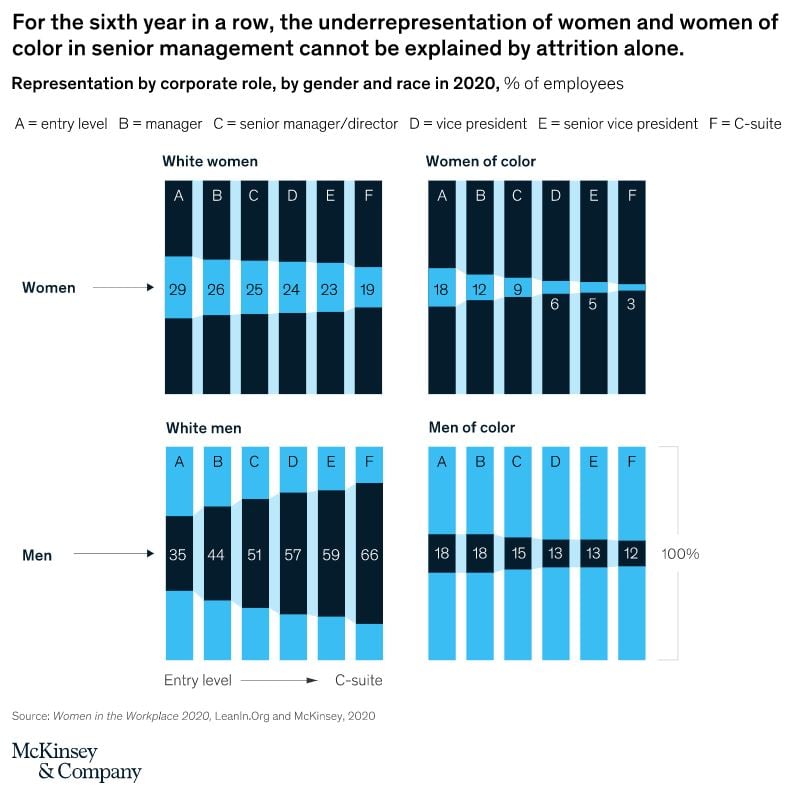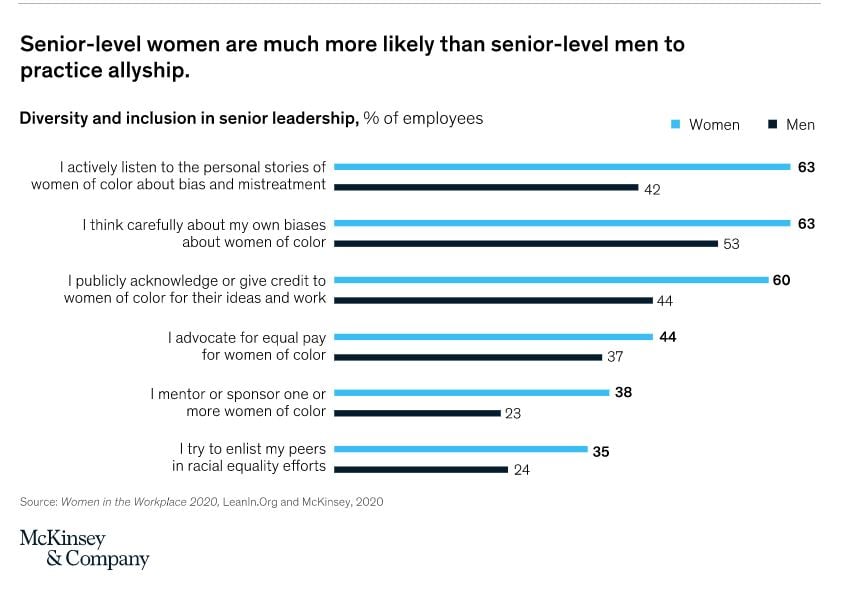
THE EXIT PLANNING BLOG
Keep up-to-date with exit planning, succession planning, industry trends, unique specialty insights, and useful content for professional advisors and business owners.
Share this
Women in Business: There is Still Work to Do
by Colleen Kowalski on March 3, 2021

If you search for “Business Person” into Google Images, the majority of the photos that appear are men in suits staring at the camera with their arms crossed. When we searched, only nine out of the first 28 images contained a woman. That is only 32% of the photographs of a “Business Person” that included a woman. While women have gained more management and leadership roles in the recent years, we are still a long way from gender parity in business, especially at the C-suite level. In Honor of International Women’s Day on March 8th, we thought we would highlight the strides women have taken towards equality in business, and what areas still can be improved.
Women in Management:
According to the US Department of Labor Women’s Bureau, as of December 2020, 57.4% of the US population, age 16 or older, is employed. However, only 52.2% of the female population 16 or older is employed compared to 62.9% of the male population in the same age range. While only a little over 10% higher, the discrepancy in the number of women promoted to a manager level position show the deeper issue. In a research study conducted by McKinsey in 2019, “For every 100 men promoted to manager, only 85 women were promoted—and this gap was even larger for some women: only 58 Black women and 71 Latinas were promoted. As a result, women remained significantly outnumbered in entry-level management at the beginning of 2020—they held just 38% of manager-level positions, while men held 62%”. While more women have been hired to entry level positions in recent years, the difficulty to advance in their careers to management positions remains, especially for women of color. According to the chart below from McKinsey, White men make up 66% of C-Suite employees while in contrast, Women of color make up only 3%.

Women in the Financial Industry:
In the banking and financial industries specifically, “women are just at parity (50%) for entry level positions, but a gender gap gradually increases along the leadership pipeline, from 42% of managers to 27% of senior vice presidents”, according to a study by Catalyst. To see a segment specific analysis of the percentage of women in the financial industry, see the following chart.
Women-Owned Businesses:
Thankfully, women owned businesses have seen a substantial increase in the past few years. According to the 2019 State Of Women-Owned Businesses Report commissioned by American Express, “Between 2014 and 2019, the number of women-owned businesses climbed 21% to a total of nearly 13 million (12,943,400)”. Additionally, in 2019 businesses owned by women of color accounted for 50% of the total women-owned businesses and accounted for 25% of the total employment in women-owned businesses. Also, women of color founded 64% of the women-owned businesses that started in the last year, according to Fundera.
Women-owned Businesses are believed to be a safer bet for investors because the business acts as the entrepreneur’s only, or main, source of income. However, women often face more scrutiny from potential investors than a man would in the same position. Businesses started by women statistically make twice as much as those started by men, according to What To Become. The National Women’s Business Council states that women are more likely to raise funds for their businesses through crowdfunding than through traditional investors.
Some Good News:
While we are far from reaching gender parity in every industry, the advancements made by women in business, especially women of color, have greatly shifted the landscape of business in the United States. Creating a diverse and safe workplace is an important step in fostering a healthy work environment for every employee. According to McKinsey, “more than 50% of senior-level women say they consistently take a public stand for gender and racial equity at work, compared with about 40% of senior-level men”. While it should not only be up to the people in positions of power to effect change in business, when senior-level leadership make it a priority to create an inclusive workplace, the rest of the business is more likely to follow.

The hope for gender parity in business, and especially finance, led Seema Hingorani to create the non-profit, Girls Who Invest, in 2015. With the mission that by 2030, 30% of the world’s capital will be managed by women, Girls Who Invest offers a variety of programs for college women interested in entering the fields of finance, markets, and asset management. The programs offer on the job training with finance professionals, educators, and investors to give the women insight in the industry.
This International Women’s Day, we invite you all to take a look at your businesses. How does your business ensure equal treatment of women in the workplace? What are you doing to combat sexism in your office? When was the last time you held a diversity training? When women have the equal opportunity to advance in business, there is no stopping their positive impact.
Share this
- Blog (546)
- CEPA (424)
- exit planning (249)
- CEPA community (187)
- Business Owner (172)
- Exit Planning Summit (97)
- EPI Chapter Network (89)
- Value Acceleration Methodology (80)
- Exit Planning Partner Network (76)
- EPI Announcement (49)
- Content (48)
- Webinars (37)
- Excellence in Exit Planning Awards (33)
- Marketing (30)
- 2024 Exit Planning Summit (28)
- 5 Stages of Value Maturity (26)
- Books (24)
- EPI Academy (24)
- EPI Team (22)
- Exit Planning Teams (22)
- Leadership (21)
- 2023 Exit Planning Summit (20)
- family business (20)
- women in business (19)
- Intangible Capital (18)
- Exit Options (17)
- Black Friday (16)
- CPA (15)
- Walking to Destiny (15)
- State of Owner Readiness (14)
- Chapters (13)
- Chris Snider (12)
- National Accounts (12)
- Small business (12)
- charitable intent (12)
- personal planning (12)
- Financial Advisors (11)
- Season of Deals (9)
- 5 Ds (8)
- About us (8)
- Podcast (8)
- Insiders Bash (7)
- Scott Snider (7)
- Christmas (6)
- Exit Planning Content Library (6)
- Case Studies (5)
- Owner Roundtables (5)
- Three Legs of the Stool (5)
- Value Advisors (5)
- financial planning (5)
- Awards (4)
- Circle of Excellence (4)
- Exit & Succession (4)
- Five Ds (4)
- executive training (4)
- EPI Thought Leadership Council (3)
- Owners Forum (3)
- author (3)
- forbes (3)
- DriveValue (2)
- Exit Is Now Podcast (2)
- Peter Christman (2)
- Veteran (2)
- Whitepapers (2)
- Business Owners Forum (1)
- SOOR (1)
- business consultants (1)






